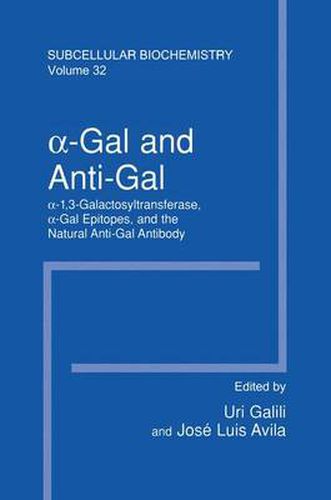Readings Newsletter
Become a Readings Member to make your shopping experience even easier.
Sign in or sign up for free!
You’re not far away from qualifying for FREE standard shipping within Australia
You’ve qualified for FREE standard shipping within Australia
The cart is loading…






This title is printed to order. This book may have been self-published. If so, we cannot guarantee the quality of the content. In the main most books will have gone through the editing process however some may not. We therefore suggest that you be aware of this before ordering this book. If in doubt check either the author or publisher’s details as we are unable to accept any returns unless they are faulty. Please contact us if you have any questions.
It has been 15 years since the first report on the isolation of anti-Gal from human serum and the demonstration that this antibody is the most prevalent antibody in humans (Galili et al. , ]. Exp. Med. 160: 1519, 1984). Subsequent interdisciplinary studies in immunology, carbohydrate biochemistry, molecular biology, and evo- lution demonstrated the highly restricted specificity of anti-Gal for the carbohy- drate epitope Gal al-3Galpl-4GIcNAc-R, (termed here the a-gal epitope), the unprecedented evolutionary pattern of distribution of a-gal and anti-Gal in mam- mals, and explained the evolution of this antigen and antibody by analysis of the a 1 ,3galactosyltransferase gene, the gene that encodes the enzyme that synthesizes the a-gal epitope. These studies have suggested that a major selection process that occurred in the course of evolution of ancestral Old World primates resulted in the inactivation of the a1 ,3galactosyltransferase gene and the subsequent appearance of anti-Gal in these primates. Other studies in immunoparasitology have demon- strated the possible physiologic significance of anti-Gal in protection against cer- tain parasitic infections. Major scientific attention was focused on a-gal and anti-Gal with the real- ization in the early nineties that the interaction between this antigen and antibody is the major obstacle to xenotransplantation. The success of immunosuppressive drugs, in the last two decades of the 20th century, in preventing allograft rejection, has raised hopes for cure in many patients in need of organ transplant. Because of limited supply of allografts, only 20% of patients receive the needed organ.
$9.00 standard shipping within Australia
FREE standard shipping within Australia for orders over $100.00
Express & International shipping calculated at checkout
This title is printed to order. This book may have been self-published. If so, we cannot guarantee the quality of the content. In the main most books will have gone through the editing process however some may not. We therefore suggest that you be aware of this before ordering this book. If in doubt check either the author or publisher’s details as we are unable to accept any returns unless they are faulty. Please contact us if you have any questions.
It has been 15 years since the first report on the isolation of anti-Gal from human serum and the demonstration that this antibody is the most prevalent antibody in humans (Galili et al. , ]. Exp. Med. 160: 1519, 1984). Subsequent interdisciplinary studies in immunology, carbohydrate biochemistry, molecular biology, and evo- lution demonstrated the highly restricted specificity of anti-Gal for the carbohy- drate epitope Gal al-3Galpl-4GIcNAc-R, (termed here the a-gal epitope), the unprecedented evolutionary pattern of distribution of a-gal and anti-Gal in mam- mals, and explained the evolution of this antigen and antibody by analysis of the a 1 ,3galactosyltransferase gene, the gene that encodes the enzyme that synthesizes the a-gal epitope. These studies have suggested that a major selection process that occurred in the course of evolution of ancestral Old World primates resulted in the inactivation of the a1 ,3galactosyltransferase gene and the subsequent appearance of anti-Gal in these primates. Other studies in immunoparasitology have demon- strated the possible physiologic significance of anti-Gal in protection against cer- tain parasitic infections. Major scientific attention was focused on a-gal and anti-Gal with the real- ization in the early nineties that the interaction between this antigen and antibody is the major obstacle to xenotransplantation. The success of immunosuppressive drugs, in the last two decades of the 20th century, in preventing allograft rejection, has raised hopes for cure in many patients in need of organ transplant. Because of limited supply of allografts, only 20% of patients receive the needed organ.